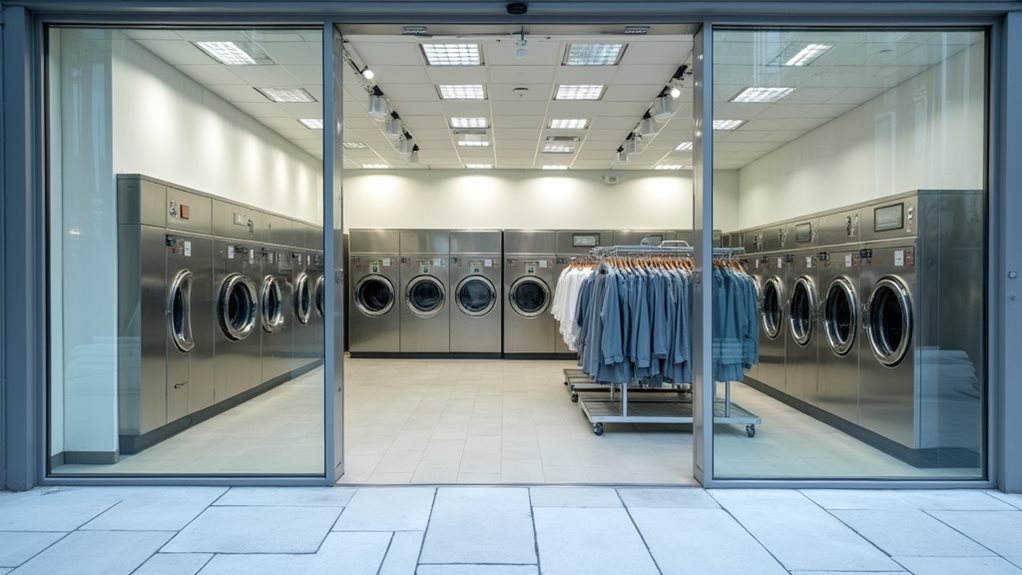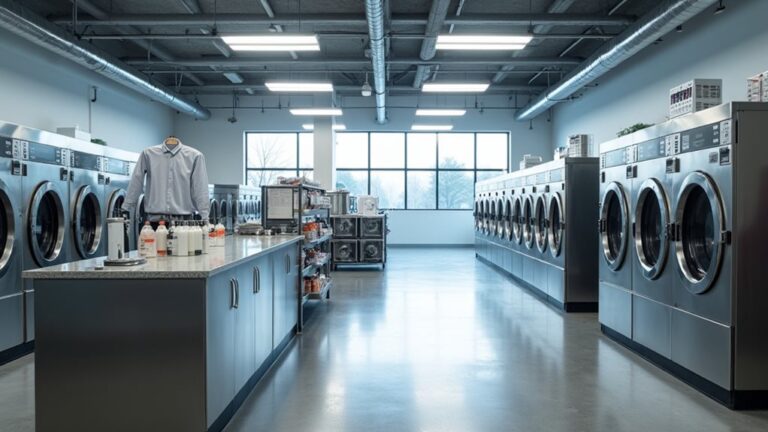Opening a dry cleaning business starts with understanding your local market—busy professionals and families who desperately need fabric care solutions. You’ll need proper licensing, a commercial location near shopping centers, and quality equipment that won’t break down during your busiest weeks. Focus on building relationships with hotels and restaurants for steady income, while establishing eco-friendly services that set you apart from competitors. The path ahead reveals vital financial and operational insights.
Market Research and Business Planning
Before you dive headfirst into the exciting world of dry cleaning entrepreneurship, you’ll need to roll up your sleeves and conduct thorough market research that’ll become the backbone of your entire venture.
Start by analyzing your target market – busy professionals, families, and millennials who value convenience over DIY laundry struggles. Study your competitors like you’re preparing for finals, identifying gaps where your unique selling propositions can shine brighter than a freshly pressed shirt ✨.
Your business plan should weave together financial projections, marketing strategies, and operational plans into one cohesive roadmap.
Don’t forget to court local businesses like hotels and restaurants – they’ll become your bread-and-butter customer base, providing steady revenue while you build your reputation in the community.
Be prepared to invest between $200,000 to $500,000 in startup costs, which will cover everything from commercial-grade equipment to securing the right location with proper ventilation systems.
Legal Requirements and Business Registration

Once you’ve mapped out your business strategy, the legal maze of registrations and permits becomes your next mountain to climb, and trust me, it’s not as intimidating as it looks from the bottom 📋.
The legal paperwork mountain looks scarier from a distance than when you’re actually climbing it step by step.
You’ll need to choose your business structure first—whether that’s an LLC or corporation—then register with your Secretary of State, which involves filing paperwork and paying a registration fee.
Next comes acquiring the necessary licenses and permits for your area, including environmental permits if you’re using certain chemicals.
Don’t forget about insurance coverage either; general liability and workers’ compensation are crucial.
Maintaining proper documentation of everything guarantees compliance and keeps your business operations running seamlessly, because nobody wants regulatory headaches down the road.
Location Selection and Equipment Investment

With your legal foundation firmly in place, the hunt for the perfect location becomes both an art and a science, requiring you to balance dreams with dollars while keeping your future customers’ convenience at the forefront of every decision 🎯.
Your location selection will make or break your business, so target commercial space near shopping centers where high foot traffic flows naturally.
Don’t forget checking zoning regulations – trust me, you’ll want this headache handled early!
Equipment investment demands serious consideration too. Commercial-grade washers aren’t cheap, but they’re your workhorses.
Budget monthly expenses carefully, including rent and utilities. Partner with reliable suppliers for maintenance of equipment because operational disruptions cost more than prevention.
Customer accessibility trumps everything else.
Expect your initial investment to range from $200,000 to $500,000, with commercial-grade dry cleaning equipment representing one of your largest single expenses.
Service Offerings and Quality Standards

After countless conversations with dry cleaning customers over the years, I’ve learned that your service offerings isn’t just a list of what you clean – it’s your promise to solve every fabric crisis that walks through your door 👔.
Your quality standards will determine whether that diverse customer base becomes loyal advocates or one-time visitors.
I’ve watched businesses thrive by focusing on specialized care for delicate fabrics, mastering stain removal techniques that seem like magic, and offering eco-friendly cleaning options for environmentally conscious clients.
Using chemical solvents instead of water ensures that you can clean fabrics without causing shrinkage, color bleeding, or structural damage that would destroy your customers’ investment pieces.
- Train your staff extensively in proper garment care techniques and customer service excellence
- Implement systematic customer feedback collection to continuously improve your standards
- Develop clear quality control processes for consistent, professional results
Marketing Strategies and Customer Acquisition

Because building a successful dry cleaning business depends heavily on attracting the right customers consistently, your marketing strategy becomes the bridge between your exceptional service quality and the community members who desperately need it.
You’ll want to adopt social media platforms like Facebook and Instagram, where customer testimonials shine brighter than freshly pressed shirts 👔.
Launch promotional campaigns offering first-time discounts, because everyone loves saving money while discovering quality service.
Establish a referral program that rewards loyal customers for spreading the word, creating organic customer acquisition through genuine recommendations.
Build partnerships with local businesses like hotels and corporate offices, transforming them into consistent referral sources.
Consider highlighting eco-friendly cleaning methods in your marketing materials to address growing environmental concerns while differentiating your business from traditional competitors.
These marketing strategies work together, boosting brand awareness while creating lasting connections that keep your business thriving.




